Fission Yeast CENP-C (Cnp3) Plays a Role in Restricting the Site of CENP-A Accumulation
- PMID: 29925533
- PMCID: PMC6071599
- DOI: 10.1534/g3.118.200486
Fission Yeast CENP-C (Cnp3) Plays a Role in Restricting the Site of CENP-A Accumulation
Abstract
The centromere is a chromosomal locus where a microtubule attachment site, termed kinetochore, is assembled in mitosis. In most eukaryotes, with the exception of holocentric species, each chromosome contains a single distinct centromere. A chromosome with an additional centromere undergoes successive rounds of anaphase bridge formation and breakage, or triggers a cell cycle arrest imposed by DNA damage and replication checkpoints. We report here a study in Schizosaccharomyces pombe to characterize a mutant (cnp3-1) in a gene encoding a homolog of mammalian centromere-specific protein, CENP-C. At the restrictive temperature 36°, the Cnp3-1 mutant protein loses its localization at the centromere. In the cnp3-1 mutant, the level of the Cnp1 (a homolog of a centromere-specific histone CENP-A) also decreases at the centromere. Interestingly, the cnp3-1 mutant is prone to promiscuous accumulation of Cnp1 at non-centromeric regions, when Cnp1 is present in excess. Unlike the wild type protein, Cnp3-1 mutant protein is found at the sites of promiscuous accumulation of Cnp1, suggesting that Cnp3-1 may stabilize or promote accumulation of Cnp1 at non-centromeric regions. From these results, we infer the role of Cnp3 in restricting the site of accumulation of Cnp1 and thus to prevent formation of de novo centromeres.
Keywords: CENP-A; CENP-C; and fission yeast; centromere.
Copyright © 2018 Suma et al.
Figures
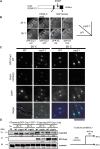

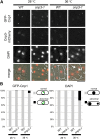

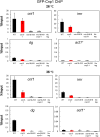
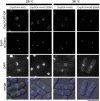
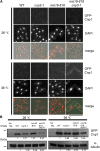
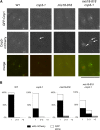
Similar articles
-
Factors that promote H3 chromatin integrity during transcription prevent promiscuous deposition of CENP-A(Cnp1) in fission yeast.PLoS Genet. 2012 Sep;8(9):e1002985. doi: 10.1371/journal.pgen.1002985. Epub 2012 Sep 20. PLoS Genet. 2012. PMID: 23028377 Free PMC article.
-
The CENP-A N-tail confers epigenetic stability to centromeres via the CENP-T branch of the CCAN in fission yeast.Curr Biol. 2015 Feb 2;25(3):348-356. doi: 10.1016/j.cub.2014.11.060. Epub 2015 Jan 22. Curr Biol. 2015. PMID: 25619765 Free PMC article.
-
The Ino80 complex mediates epigenetic centromere propagation via active removal of histone H3.Nat Commun. 2017 Sep 13;8(1):529. doi: 10.1038/s41467-017-00704-3. Nat Commun. 2017. PMID: 28904333 Free PMC article.
-
Heterochromatin tells CENP-A where to go.Bioessays. 2008 Jun;30(6):526-9. doi: 10.1002/bies.20763. Bioessays. 2008. PMID: 18478529 Review.
-
Two distinct pathways responsible for the loading of CENP-A to centromeres in the fission yeast cell cycle.Philos Trans R Soc Lond B Biol Sci. 2005 Mar 29;360(1455):595-606; discussion 606-7. doi: 10.1098/rstb.2004.1614. Philos Trans R Soc Lond B Biol Sci. 2005. PMID: 15897182 Free PMC article. Review.
Cited by
-
Centromere deletion in Cryptococcus deuterogattii leads to neocentromere formation and chromosome fusions.Elife. 2020 Apr 20;9:e56026. doi: 10.7554/eLife.56026. Elife. 2020. PMID: 32310085 Free PMC article.
-
Recent insights into mechanisms preventing ectopic centromere formation.Open Biol. 2021 Sep;11(9):210189. doi: 10.1098/rsob.210189. Epub 2021 Sep 8. Open Biol. 2021. PMID: 34493071 Free PMC article. Review.
-
Cdc48 and its co-factor Ufd1 extract CENP-A from centromeric chromatin and can induce chromosome elimination in the fission yeast Schizosaccharomyces pombe.Biol Open. 2024 Apr 15;13(4):bio060287. doi: 10.1242/bio.060287. Epub 2024 Apr 8. Biol Open. 2024. PMID: 38526189 Free PMC article.
References
Publication types
MeSH terms
Substances
LinkOut - more resources
Full Text Sources
Other Literature Sources
Molecular Biology Databases
